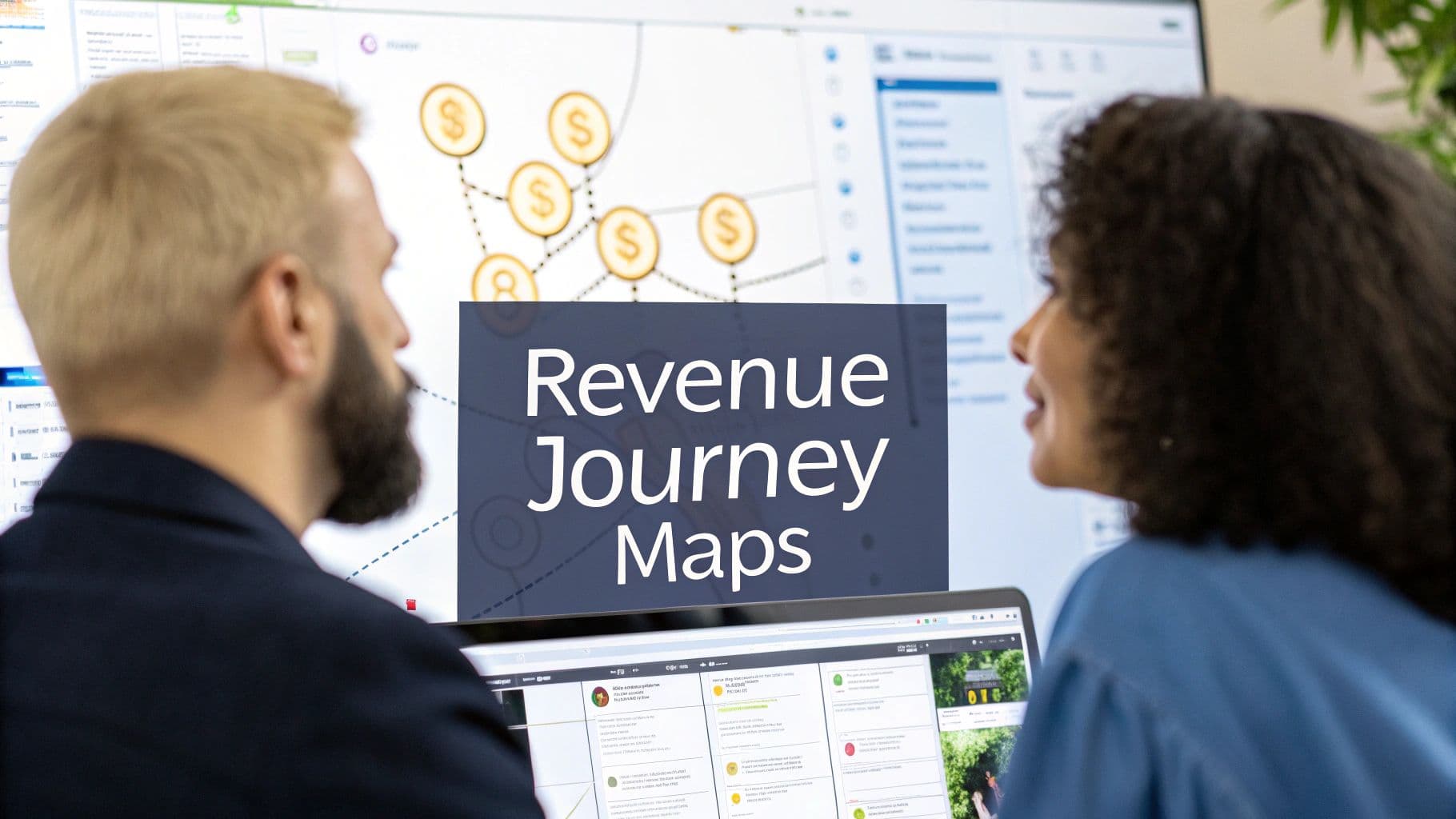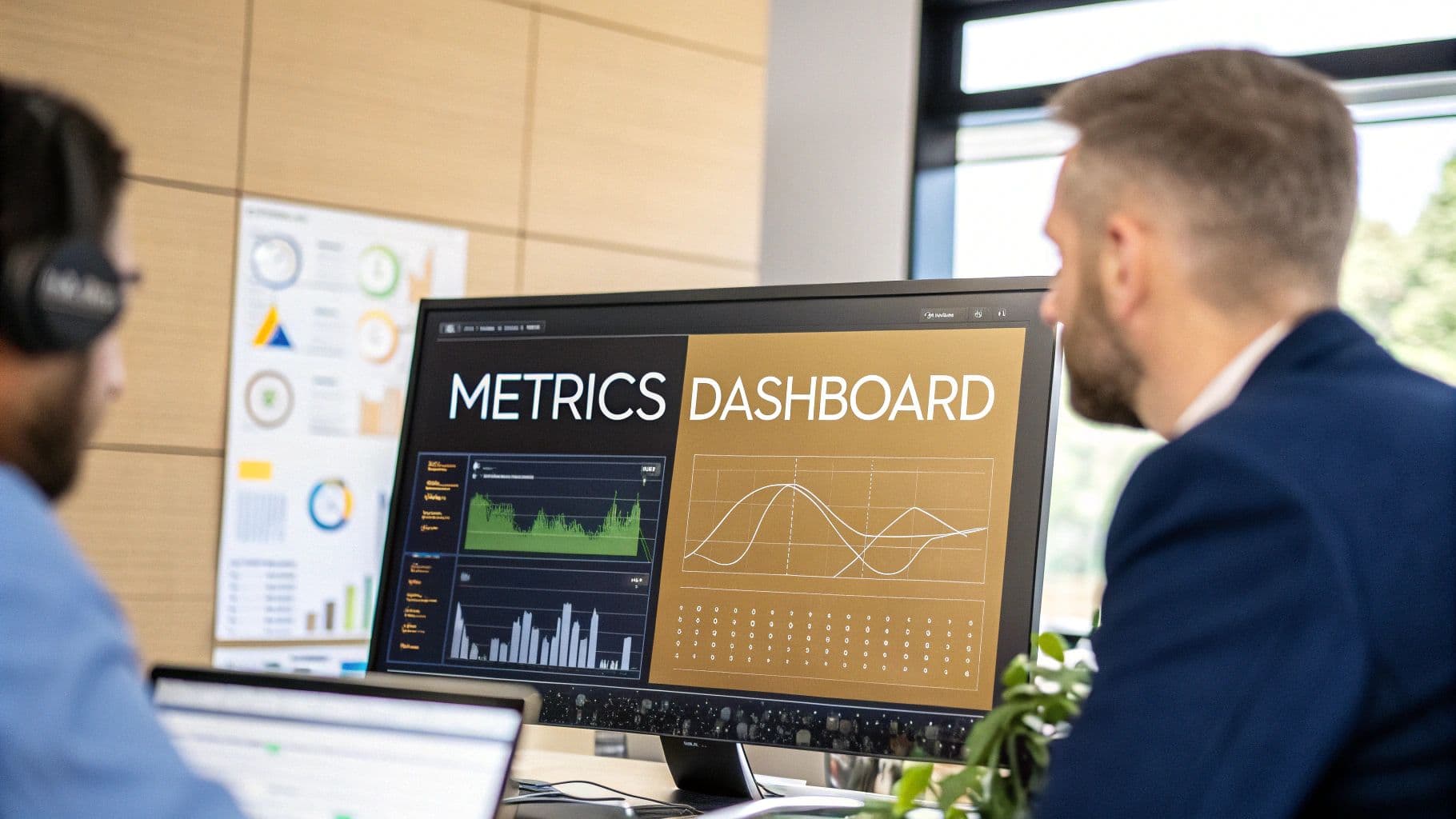12 Best Predictive Analytics Software Options for 2025
Discover the 12 best predictive analytics software platforms for 2025. Compare features, pricing, and use cases to find the right tool for your data team.
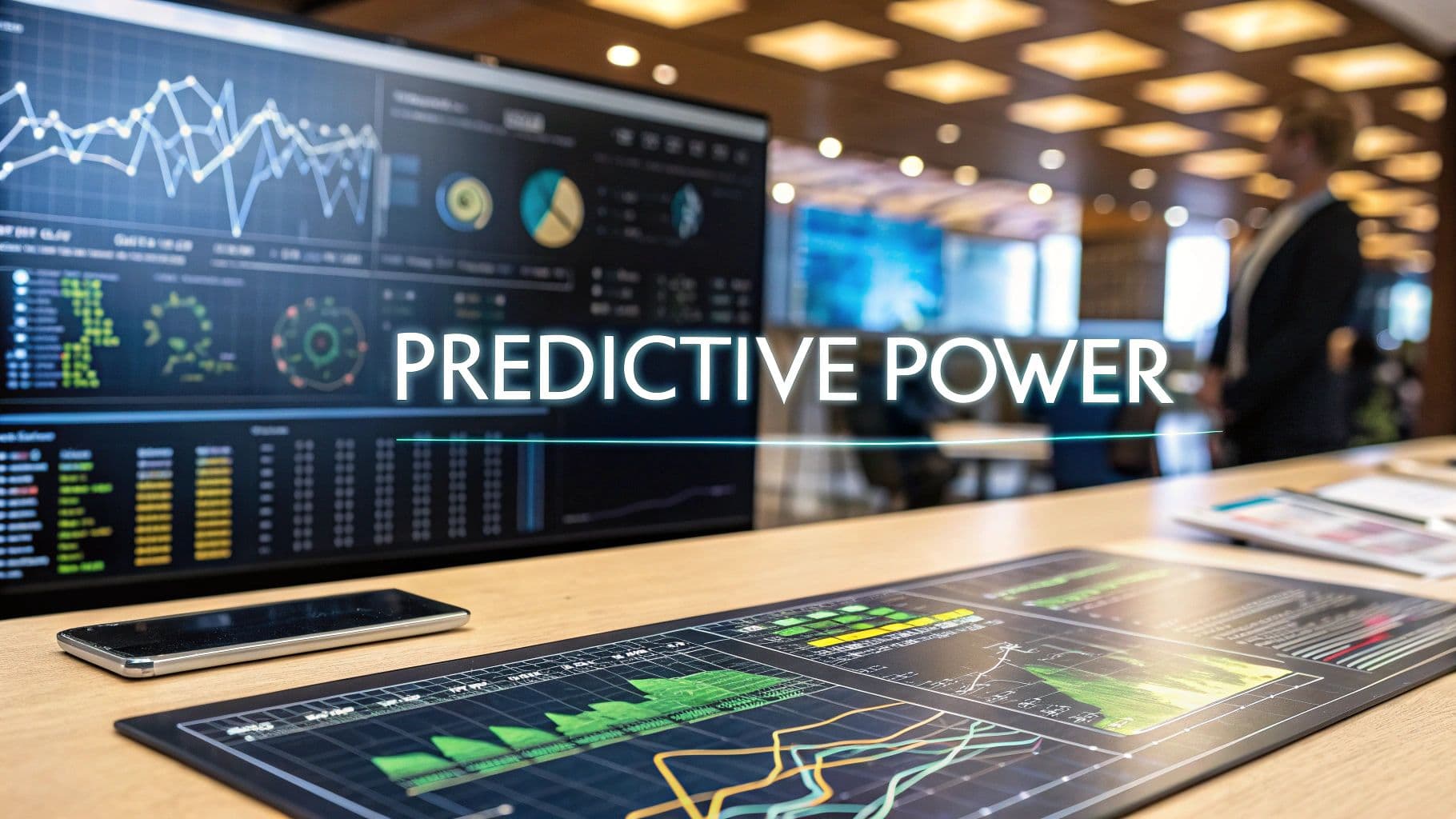
Making data-driven decisions is no longer a luxury; it's a core requirement for staying competitive. But how do you move from analyzing past events to accurately forecasting future outcomes? The answer lies in using the best predictive analytics software to transform raw data into actionable intelligence. These platforms empower teams to anticipate customer churn, forecast demand, detect fraud, and optimize marketing campaigns with a high degree of accuracy.
This guide is designed to help SaaS product managers, data analysts, and technical leads navigate the complex market of predictive tools. We've compiled a comprehensive list of the leading solutions, from enterprise-grade cloud platforms to more accessible, user-friendly applications. To truly leverage these tools, it's essential to grasp the basics of What Is Predictive Modeling and how it underpins their functionality.
Our goal is to cut through the marketing noise and provide a practical resource. For each software option, you will find a detailed analysis of its core features, ideal use cases, pricing structures, and an honest look at its pros and cons. We've included screenshots and direct links to help you evaluate which platform best aligns with your team's technical skills, budget, and specific business objectives.
1. SigOS
SigOS stands out as one of the best predictive analytics software solutions specifically engineered for SaaS companies seeking to translate customer feedback into revenue. It moves beyond traditional sentiment analysis by correlating qualitative data from sources like support tickets, sales calls, and chat transcripts with quantitative user behavior. This AI-driven product intelligence platform excels at identifying the underlying signals that directly impact churn, expansion, and revenue leakage.
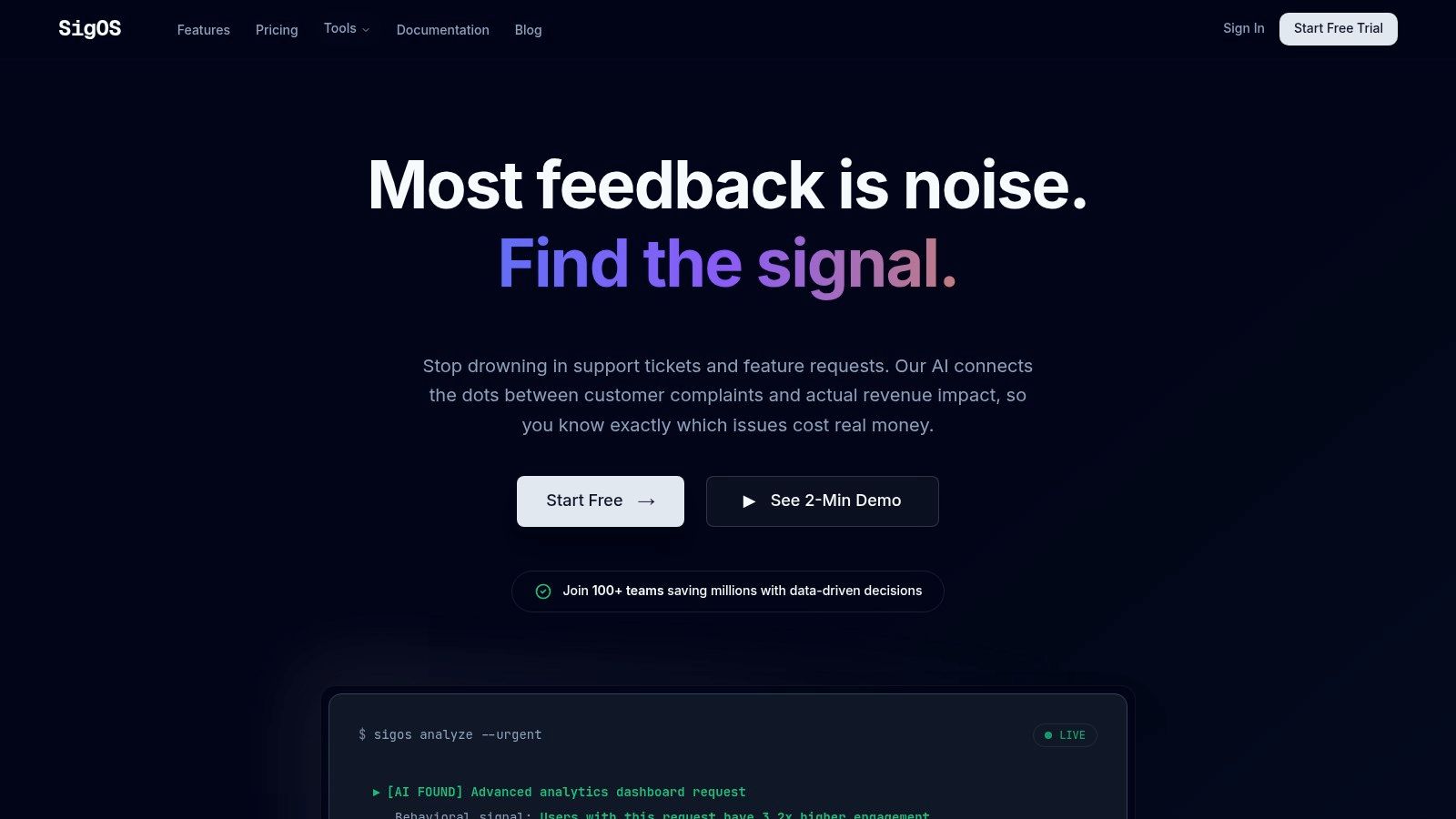
The platform's core strength lies in its ability to deliver monetized insights. Instead of just flagging popular requests, SigOS quantifies the revenue impact of specific issues and feature gaps, allowing product and growth teams to prioritize their roadmap with exceptional clarity. Its daily dashboards and sub-minute analysis times ensure that high-impact opportunities are never missed.
Key Features & Use Cases
- Revenue-Tied Insights: SigOS analyzes behavioral and feedback data to reveal patterns with an 87% correlation to revenue events. This helps teams pinpoint which issues are causing churn or blocking high-value deals.
- Automated Workflow Integration: Seamless connections with tools like Zendesk, Jira, Intercom, and GitHub automate the process of creating and prioritizing development tasks. Issues are populated with revenue impact scores, saving significant manual effort.
- Proactive Churn Reduction: By identifying at-risk customer segments based on their feedback and behavior, teams can intervene proactively. For a deeper dive into this, you can explore how SigOS approaches churn prediction models to better understand its methodology.
- Security and Privacy: The platform employs a security-first architecture with end-to-end encryption and a strict policy of not retraining its models on client data, ensuring confidentiality.
Pricing and Onboarding
Pricing for SigOS is available upon consultation, as it is tailored to specific business needs. The platform's advanced AI capabilities may require a brief onboarding period for teams to fully leverage its behavioral analytics insights and integrate them into their existing workflows.
Website: https://sigos.io
2. Microsoft Azure Machine Learning
Microsoft Azure Machine Learning is a comprehensive, cloud-based platform designed for building, deploying, and managing predictive models at scale. It excels by providing a unified environment that caters to both data scientists who prefer coding with SDKs/CLIs and business analysts who leverage its visual, no-code Studio UI. This flexibility makes it a powerful choice for organizations with diverse technical skill sets looking for a robust predictive analytics software solution.
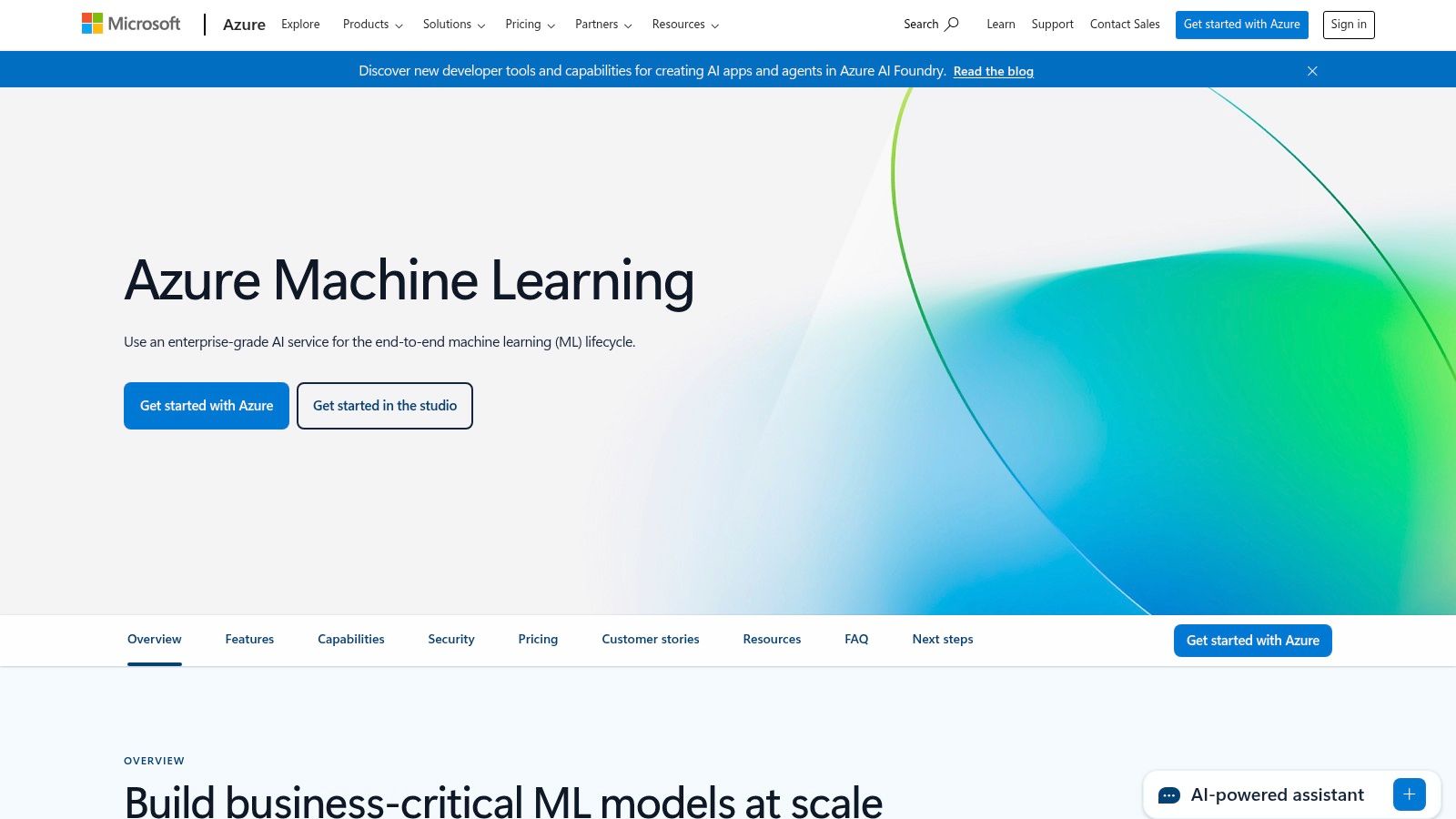
The platform stands out for its deep integration with the broader Azure ecosystem and its strong focus on MLOps. Users can automate the entire machine learning lifecycle, from data preparation and model training with AutoML to deployment and monitoring using managed endpoints. This end-to-end capability is crucial for SaaS teams needing to operationalize predictive insights, such as customer churn forecasts or lead scoring models, directly within their applications.
Key Features & Considerations
- Pricing: Azure ML utilizes a pay-as-you-go model, charging only for the specific compute and storage resources consumed. This avoids upfront platform fees but requires careful cost management across interconnected services.
- Pros: Its enterprise-grade security, seamless integration with Azure Active Directory, and extensive compliance certifications make it ideal for regulated industries.
- Cons: The learning curve can be steep, and accurately forecasting costs is complex due to the multi-service architecture.
Website: Microsoft Azure Machine Learning
3. Google Cloud Vertex AI
Google Cloud Vertex AI is a unified MLOps platform designed to accelerate the development and deployment of machine learning models. It provides a comprehensive suite of tools that allows teams to build, train, deploy, and monitor predictive models across various data types, including tabular, text, vision, and time-series. This makes it an exceptional choice for organizations looking to manage the entire machine learning lifecycle on a single, integrated platform.
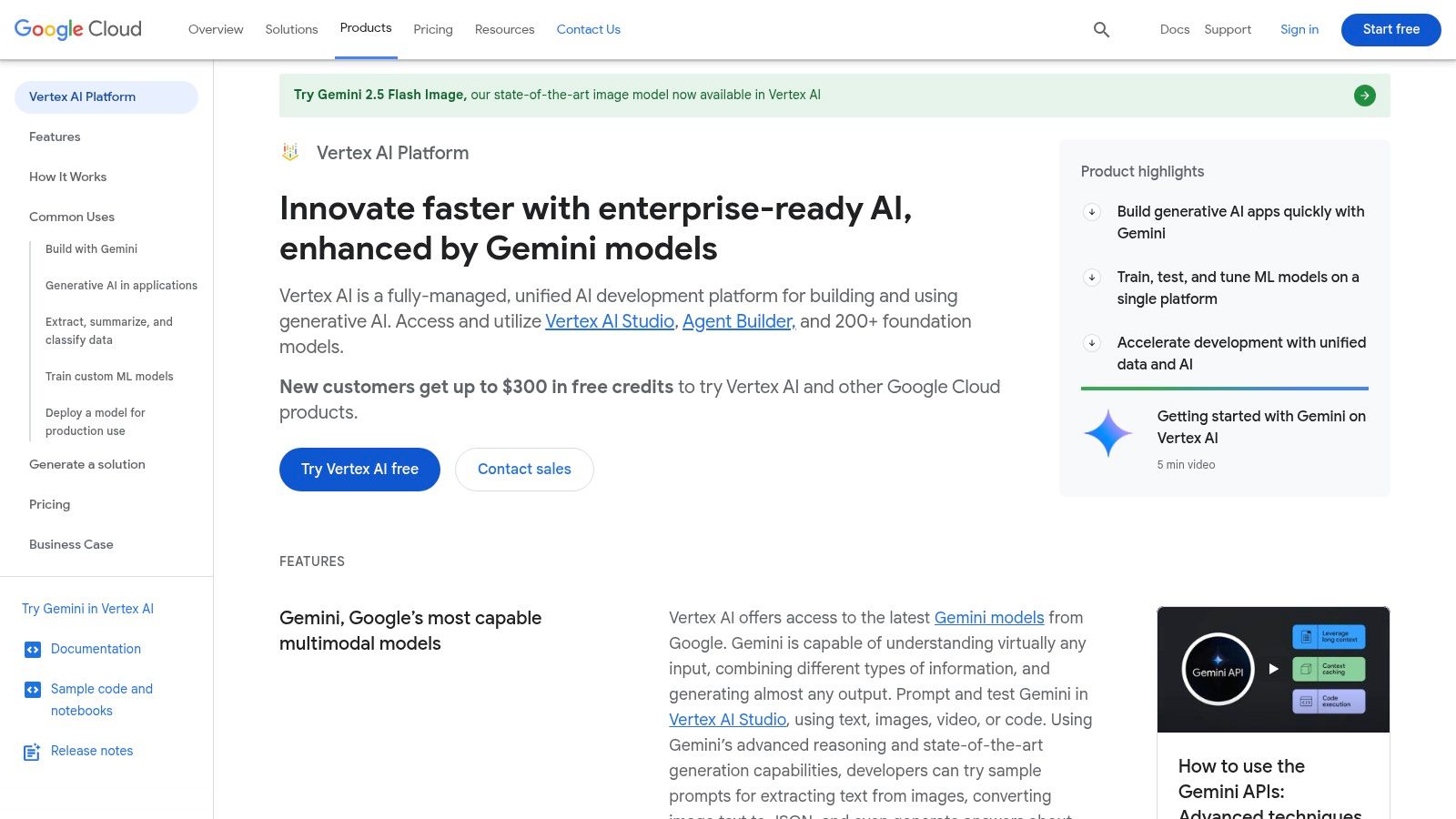
The platform’s key advantage is its tight integration with the broader Google Cloud ecosystem, especially BigQuery, which simplifies data access and feature engineering. Vertex AI supports both AutoML for users who need to build models with minimal code, and custom training for data scientists requiring full control over their model architecture. This versatility makes it a powerful predictive analytics software option for SaaS teams aiming to embed forecasting, classification, or recommendation capabilities directly into their products.
Key Features & Considerations
- Pricing: Vertex AI employs a granular, pay-as-you-go model where costs are broken down by specific feature, such as model training hours, prediction requests, or data labeling.
- Pros: Its deep integration with BigQuery streamlines data pipelines, and its well-documented, fine-grained pricing allows for transparent cost tracking.
- Cons: The variable cost structure requires diligent estimation to manage budgets effectively, and the platform is best suited for teams already familiar with the Google Cloud environment.
Website: Google Cloud Vertex AI
4. Amazon SageMaker
Amazon SageMaker is a fully managed AWS service that provides every developer and data scientist with the ability to build, train, and deploy machine learning models quickly. It streamlines the entire ML workflow, offering everything from managed notebooks for data exploration to one-click deployment for production models. This integrated, end-to-end approach makes it a premier choice for teams already operating within the AWS ecosystem looking for a powerful predictive analytics software.
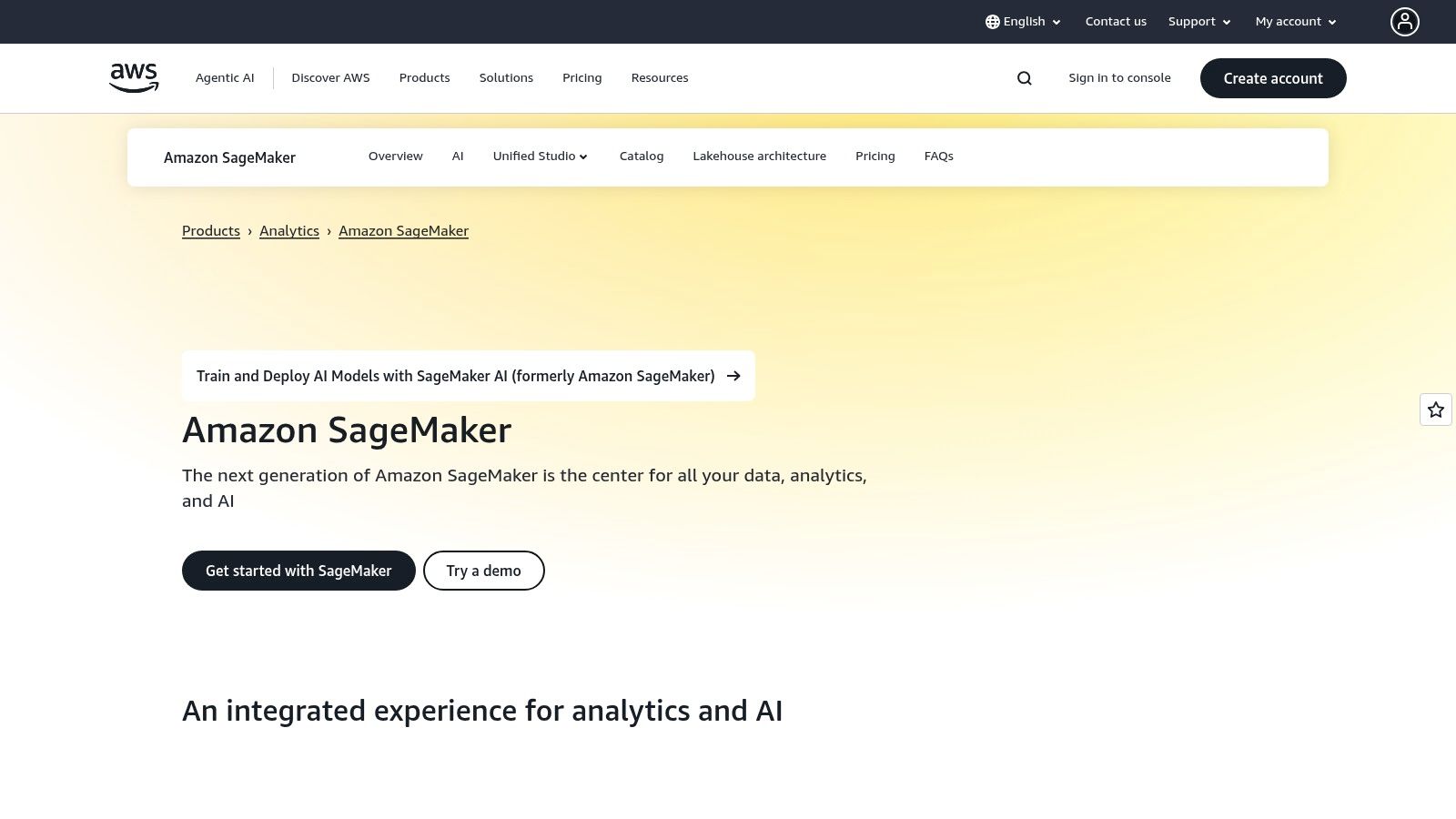
The platform's key advantage is its modularity and deep integration with other AWS services like S3 for data storage and IAM for secure access control. Features like SageMaker AutoPilot automate the model creation process, while MLOps capabilities through SageMaker Pipelines help teams manage and automate CI/CD for their predictive models. This makes it highly effective for SaaS teams aiming to embed predictive functionalities, such as personalized recommendations or fraud detection, directly into their applications.
Key Features & Considerations
- Pricing: SageMaker uses a pay-as-you-go model, with costs broken down by specific components like notebook instance usage, training job duration, and model hosting.
- Pros: Deep integration with the vast AWS services portfolio (S3, IAM, CloudWatch) offers unmatched flexibility and scalability for existing AWS users.
- Cons: The intricate pricing structure across numerous services can be complex to forecast and manage, and the platform is best suited for teams already invested in AWS.
Website: Amazon SageMaker
5. Databricks Machine Learning (Mosaic AI)
Databricks Machine Learning provides a unified, data-centric AI platform built on the lakehouse architecture, seamlessly integrating data engineering with the machine learning lifecycle. It excels at empowering collaborative teams to go from raw data to production-ready predictive models without switching environments. This integration makes it a top-tier predictive analytics software choice for organizations already invested in large-scale data processing and analytics, as it allows for a frictionless transition from ETL to model training and deployment.
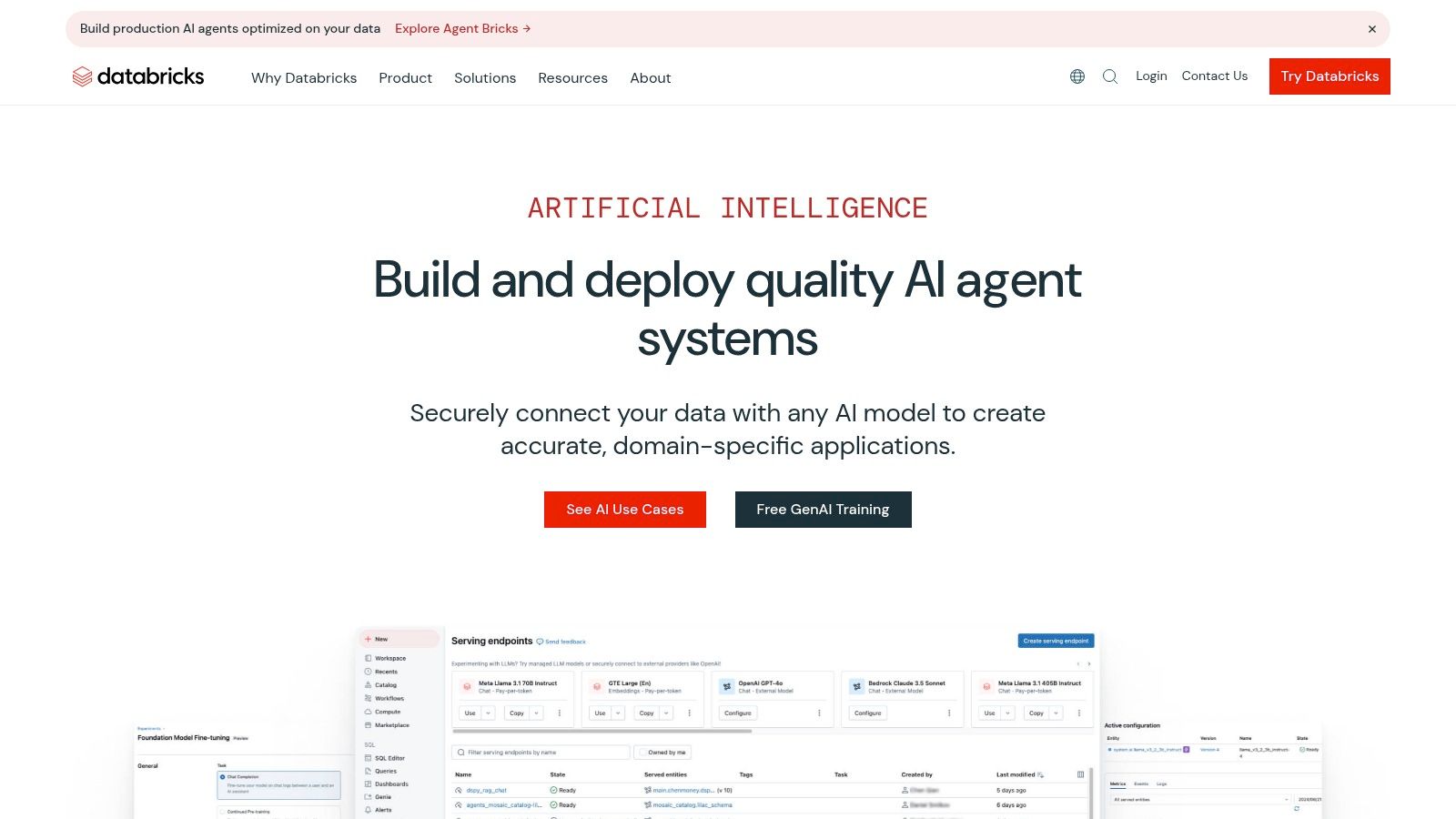
The platform’s strength lies in its comprehensive toolset, which includes feature engineering, managed MLflow for experiment tracking, AutoML, and integrated model serving. By centralizing these capabilities, SaaS teams can rapidly iterate on predictive models for use cases like customer lifetime value or dynamic pricing. For a deeper look into its role, you can explore more about enterprise data analytics and how unified platforms are shaping the industry. This unified approach simplifies MLOps and accelerates the path to generating business value from machine learning.
Key Features & Considerations
- Pricing: Databricks uses a usage-based model priced in Databricks Units (DBUs), with costs varying by compute type and cloud provider. This is billed on top of your cloud provider's infrastructure fees.
- Pros: The single platform for both data engineering and machine learning streamlines workflows and reduces data movement, improving efficiency and governance.
- Cons: The combined DBU and cloud infrastructure pricing can be complex to forecast, and the platform may be overly powerful for smaller, one-off projects.
Website: Databricks Machine Learning
6. IBM SPSS Modeler
IBM SPSS Modeler is a long-standing data science and predictive analytics platform renowned for its visual, flow-based interface. It empowers users to build predictive models through a drag-and-drop canvas, making complex data mining accessible to business analysts while still offering the depth required by data scientists. This hybrid approach allows teams to visually map out data preparation, modeling, and deployment pipelines, integrating seamlessly with open-source tools like Python and R when deeper customization is needed.
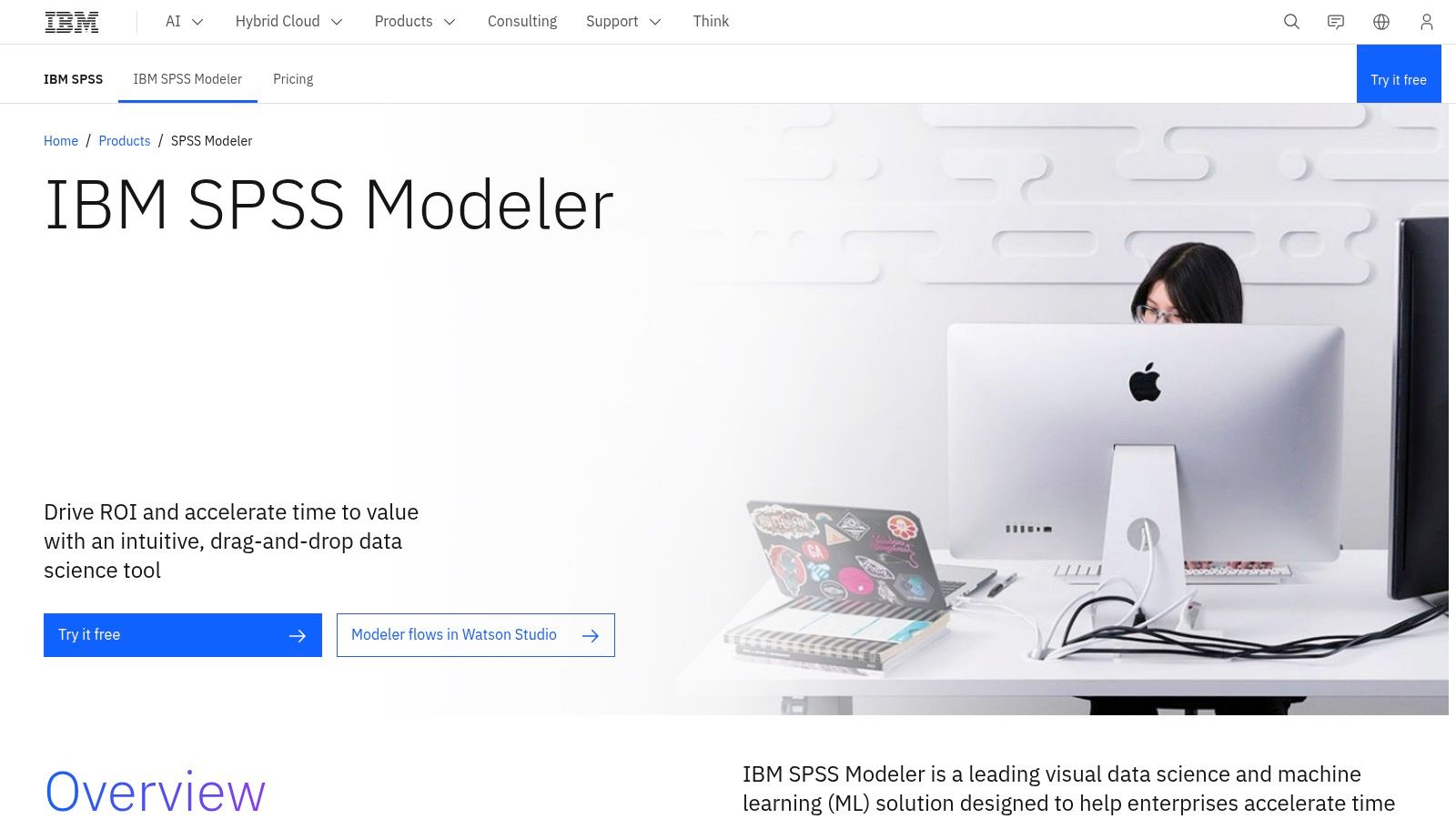
The platform's strength lies in its extensive library of pre-built algorithms and its enterprise-grade governance features, particularly in its on-premises and server editions. SaaS teams can leverage it for sophisticated tasks like customer segmentation or fraud detection without writing extensive code. As one of the best predictive analytics software options for established enterprises, it bridges the gap between traditional business intelligence and modern machine learning workflows, supporting both on-premises and hybrid cloud deployments.
Key Features & Considerations
- Pricing: IBM uses subscription and perpetual licensing models, which can be more expensive upfront compared to consumption-based cloud tools.
- Pros: Its low-code, visual workflow is highly effective for line-of-business users, and its mature governance and deployment tools are robust for enterprise needs.
- Cons: The user interface feels more traditional than modern cloud platforms, and its cost structure may be a barrier for smaller teams or startups.
Website: IBM SPSS Modeler
7. SAS Viya (Machine Learning)
SAS Viya is an enterprise-grade, cloud-native machine learning and predictive analytics platform with a long-standing reputation for robust performance in regulated industries. It provides a highly scalable, in-memory analytics engine that supports the entire analytics lifecycle, from data exploration and feature engineering to model deployment and management. The platform is designed for collaboration, offering both visual workflows in its Model Studio interface and programmatic access through Python and R integrations.
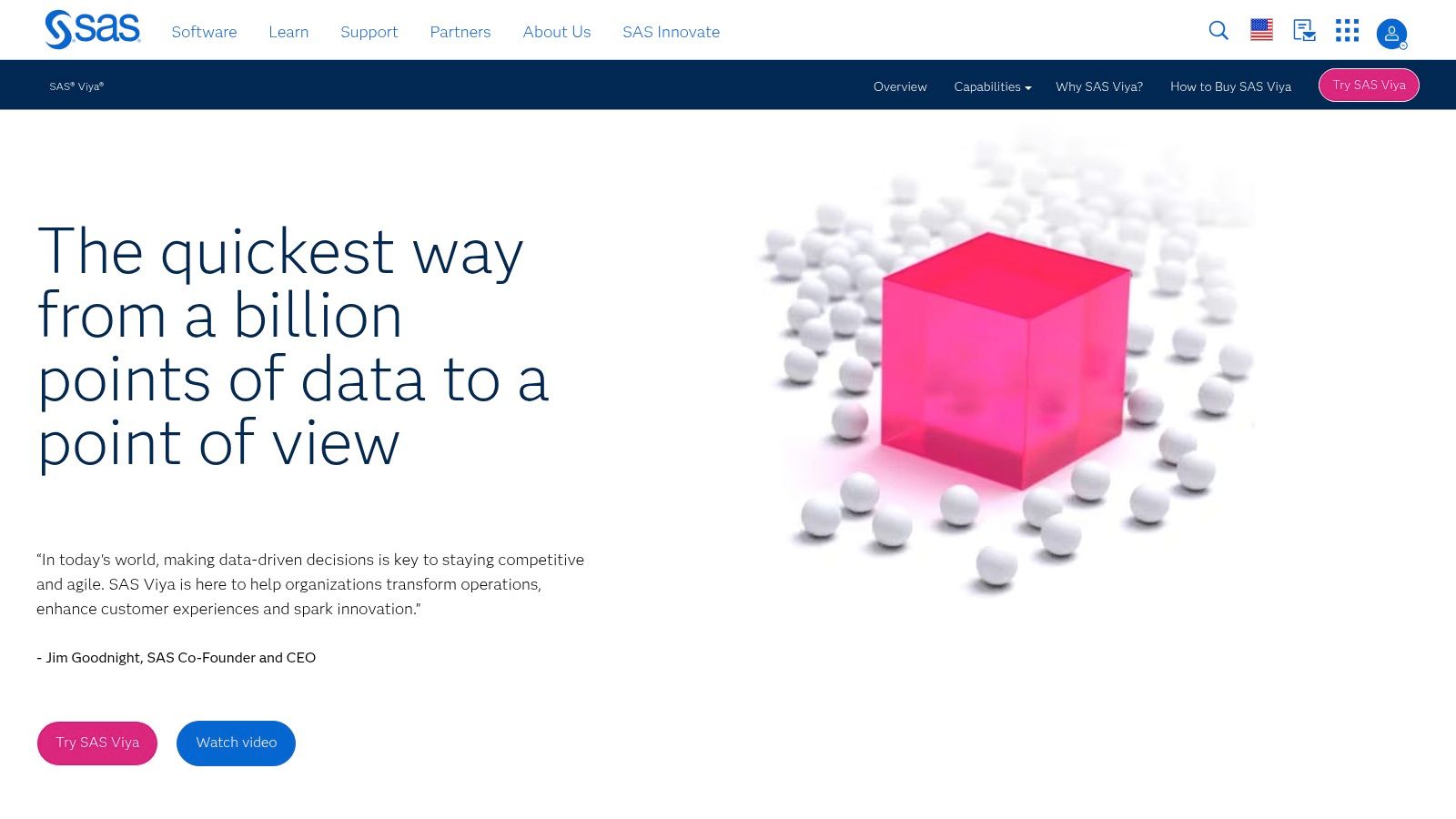
What sets SAS Viya apart is its deep focus on governance and ModelOps, making it one of the best predictive analytics software choices for organizations where auditability and compliance are non-negotiable. Its comprehensive toolset includes specialized modules for econometrics, optimization, and advanced forecasting, catering to complex business problems. This end-to-end, governed approach ensures that models are not only accurate but also transparent and responsibly managed from development through production.
Key Features & Considerations
- Pricing: Pricing is quote-based and tailored to large enterprise deployments, often involving complex licensing and hosting arrangements.
- Pros: Its strong track record in regulated sectors like finance and healthcare, combined with a comprehensive analytics portfolio, provides unmatched reliability and depth.
- Cons: The enterprise focus results in a high cost of entry and complexity that can be prohibitive for smaller teams or startups.
Website: SAS Viya
8. Alteryx (Designer Cloud/Desktop)
Alteryx is a widely recognized low-code analytics automation platform that excels in data preparation, blending, and advanced analytics. Its visual, drag-and-drop workflow environment empowers data analysts and business users to build sophisticated predictive models without writing extensive code. The platform's unified cloud and desktop licensing provides flexibility, making it an accessible yet powerful predictive analytics software choice for teams looking to democratize data science.
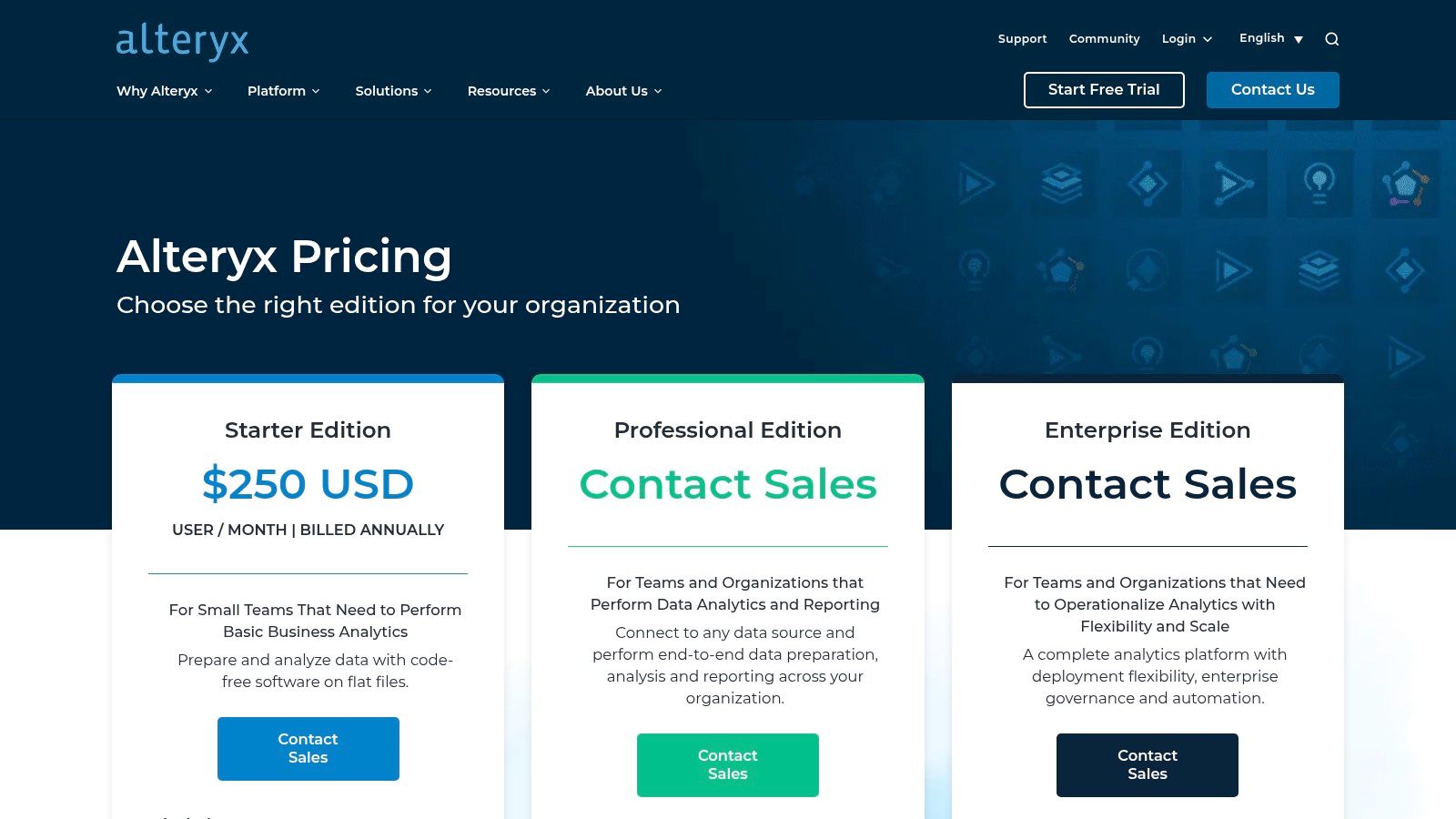
What sets Alteryx apart is its foundation in self-service analytics, which it extends into the predictive space with built-in tools for regression, forecasting, and classification. The introduction of features like an AI Copilot for workflow creation and Auto Insights for automated data storytelling further lowers the barrier to entry. This approach allows SaaS teams to quickly move from raw data to actionable insights, like identifying at-risk customers or segmenting users for targeted campaigns, all within a single, governed environment.
Key Features & Considerations
- Pricing: Alteryx offers published subscription pricing for its core Designer editions, with costs based on user licenses. Enterprise-level features and server deployments require custom quotes.
- Pros: The platform is highly approachable for analysts, supported by a rich community and extensive training resources that accelerate user adoption.
- Cons: Total cost can escalate significantly with add-ons and large-scale deployments, and its ETL origins can limit performance on complex machine learning tasks compared to native cloud ML platforms.
Website: Alteryx
9. KNIME
KNIME is a free, open-source platform that brings powerful predictive analytics to the desktop through an intuitive, visual workflow interface. It democratizes data science by allowing users to build complex models by dragging and dropping nodes, connecting them to create end-to-end data pipelines without writing code. This makes it an exceptional choice for teams with mixed technical abilities, from business analysts to seasoned data scientists, seeking a robust, no-cost entry into predictive modeling.
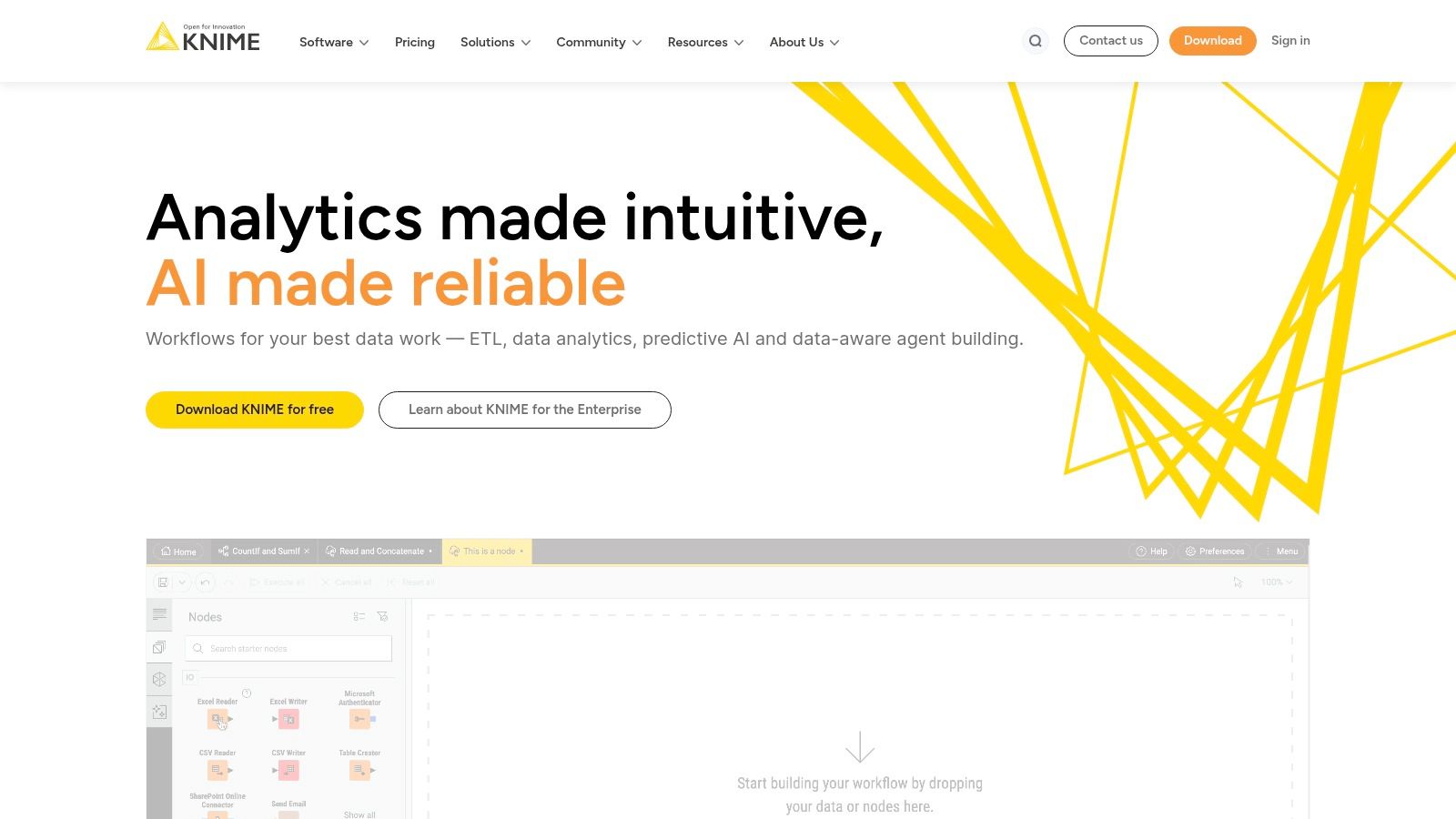
The platform’s strength lies in its modularity and extensive library of integrations, supported by a vibrant community. While the core KNIME Analytics Platform is free for individual use, paid offerings like the Business Hub provide the necessary governance, automation, and collaboration features for enterprise-scale deployments. This tiered approach allows SaaS teams to develop and test predictive models locally for free before scaling them into production environments for tasks like lead scoring or customer segmentation.
Key Features & Considerations
- Pricing: The KNIME Analytics Platform is free and open-source for desktop use. Paid editions are required for server-based automation, collaboration, and enterprise governance.
- Pros: Its zero-cost entry for powerful local analytics and a strong user community with hundreds of extensions make it highly accessible.
- Cons: Key features like workflow automation and collaboration are locked behind paid tiers, and the metered pricing for cloud execution can introduce cost management complexity.
Website: KNIME
10. Altair AI Studio (formerly RapidMiner Studio)
Altair AI Studio, which builds upon the legacy of RapidMiner, is a visual data science and machine learning platform designed for accessibility and extensibility. It empowers teams to build and deploy predictive models using a drag-and-drop, workflow-based interface, which is ideal for users who prefer visual development over extensive coding. This makes it a strong contender for organizations aiming to democratize data science without sacrificing the ability for advanced users to integrate custom code.
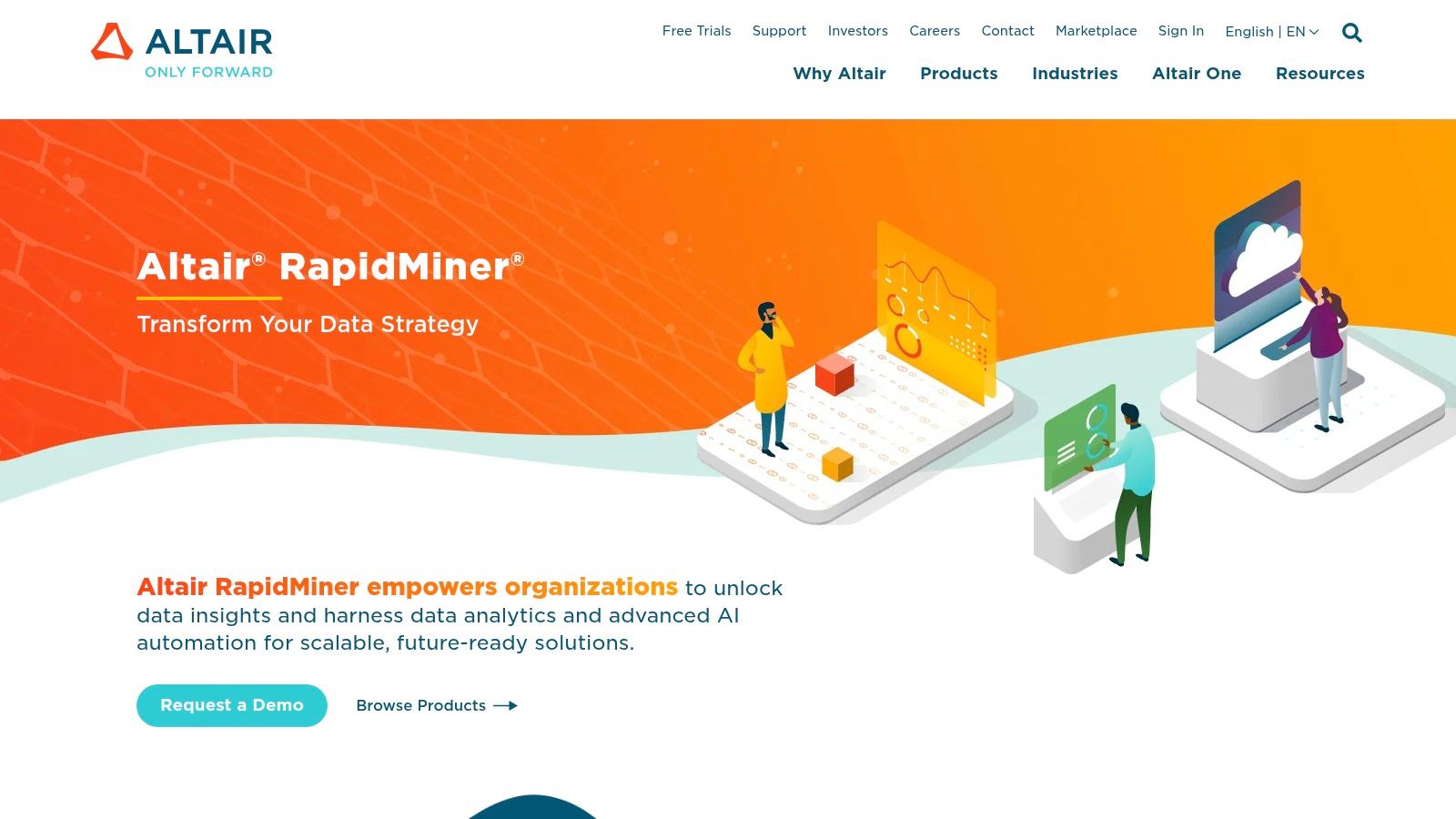
The platform shines in its blended approach, allowing data analysts to construct complex data prep and modeling processes visually while enabling data scientists to enhance them with R or Python scripts. This hybrid model, combined with enterprise-grade features for collaboration and automation through its Server and Hub components, makes it a versatile piece of predictive analytics software. Its long-standing community and extensive learning resources provide a solid foundation for new users.
Key Features & Considerations
- Pricing: A generous free edition is available for non-commercial and academic use, while commercial pricing typically requires a direct quote and involves longer-term commitments.
- Pros: The familiar workflow metaphor inherited from RapidMiner is backed by strong learning support and excellent community communication regarding product packaging.
- Cons: Commercial pricing is less transparent than pay-as-you-go models, and its ecosystem is smaller compared to the massive hyperscaler ML platforms.
Website: Altair AI Studio
11. H2O.ai Driverless AI
H2O.ai Driverless AI is an enterprise-grade automated machine learning (AutoML) platform designed to accelerate the creation of predictive models. It automates some of the most time-consuming aspects of data science, including advanced feature engineering, model selection, and hyperparameter tuning, making it a strong contender for the best predictive analytics software for teams that need to deploy high-quality models quickly. This focus on automation allows data scientists to function more like strategic reviewers than hands-on builders.
The platform's strength lies in its sophisticated, automatic creation of model pipelines for tabular and time-series data. It generates highly accurate models and provides detailed "machine learning interpretability" (MLI) reports, which are crucial for explaining model predictions and ensuring regulatory compliance. Its flexible deployment options, from on-premises servers to cloud VMs and a BYOL (Bring Your Own License) model on AWS Marketplace, cater to diverse enterprise infrastructure needs. If you want to dive deeper into how this works, you can explore the applications of SaaS artificial intelligence.
Key Features & Considerations
- Pricing: Driverless AI is available via enterprise-level subscriptions, with pricing provided on a quote-by-quote basis depending on the scale of deployment and usage.
- Pros: It delivers exceptionally fast and high-quality model pipelines and offers flexible deployment across on-premises, cloud, and hybrid environments.
- Cons: The platform’s enterprise pricing model can be a significant investment, making it better suited for larger, well-funded teams with long-term predictive use cases.
Website: H2O.ai Driverless AI
12. G2 – Predictive Analytics Software Category
While not a predictive analytics tool itself, G2’s dedicated category is an essential resource for researching and comparing the best predictive analytics software on the market. It serves as a vendor-neutral marketplace, consolidating detailed information, user reviews, and comparative Grid reports for over 200 different platforms. This makes it an invaluable first stop for teams to shortlist vendors based on real-world feedback and specific business needs like company size or industry focus.
The platform excels at providing transparency into a complex market. Users can filter solutions by features, satisfaction ratings, and market presence, creating side-by-side comparisons to evaluate how different tools stack up. This research is critical for SaaS companies aiming to implement solutions for churn prediction or lead scoring. To understand the broader market dynamics for such tools, you might find valuable insights into marketing AI B2B SaaS products. G2’s buyer’s guides further help decision-makers navigate their options effectively.
Key Features & Considerations
- Pricing: Access to G2’s comparison tools and reviews is completely free for software buyers, with revenue generated from vendor listings and promotional placements.
- Pros: It provides comprehensive, unbiased user feedback and highlights emerging tools, making it an excellent pre-purchase research platform.
- Cons: Pricing data can occasionally lag behind current vendor offers, and sponsored placements may influence the visibility of certain tools.
Website: G2 – Predictive Analytics Software Category
Top 12 Predictive Analytics Software Comparison
| Product | Core Features / Insights | User Experience & Quality ★ | Value Proposition & Pricing 💰 | Target Audience 👥 | Unique Selling Points ✨ |
|---|---|---|---|---|---|
| SigOS 🏆 | AI-driven behavioral analysis, 87% correlation | Daily dashboards, real-time alerts ★★★★ | Custom pricing, high ROI 💰💰 | SaaS product & growth teams 👥 | Automated revenue impact scoring, security-first encryption ✨ |
| Microsoft Azure Machine Learning | AutoML, MLOps, SDK/CLI, batch & real-time inference | Enterprise-grade, steep learning curve ★★★ | Pay-as-you-go, complex cost modeling 💰 | Enterprise developers & data scientists 👥 | Integrated with Azure ecosystem, strong compliance ✨ |
| Google Cloud Vertex AI | AutoML, custom training, model registry | Well-documented pricing, good UI ★★★ | Feature-based pricing, variable cost 💰 | Google Cloud users & ML engineers 👥 | Vector search, BigQuery integration ✨ |
| Amazon SageMaker | AutoPilot, notebooks, pipelines, monitoring | Deep AWS integration, complex UX ★★★ | Instance+storage pricing, AWS-centric 💰 | AWS cloud users & enterprises 👥 | Wide AWS ecosystem, marketplace integrations ✨ |
| Databricks Machine Learning | Lakehouse, AutoML, MLflow, real-time serving | Unified data+ML platform, flexible ★★★ | DBU-based pricing + cloud fees 💰 | Data engineers & ML teams 👥 | Combined ETL+ML, multi-cloud support ✨ |
| IBM SPSS Modeler | Visual workflows, extensive algos, on-prem/cloud | Low-code, traditional feel ★★★ | Subscription/perpetual licenses 💰 | Business analysts & data scientists 👥 | Drag-and-drop ease, Python/R integration ✨ |
| SAS Viya (Machine Learning) | AutoML, in-memory scaling, governance | Enterprise focus, regulated industries ★★★ | Quote-based enterprise pricing 💰 | Large regulated enterprises 👥 | Strong governance, econometrics & forecasting ✨ |
| Alteryx (Designer Cloud/Desktop) | Low-code data prep, AI Copilot, predictive analytics | Analyst-friendly, published pricing ★★★ | Transparent pricing, add-ons costly 💰 | Data analysts & business users 👥 | Unified cloud/desktop, AI-powered insights ✨ |
| KNIME | Open-source desktop, visual workflows, enterprise editions | Free core, strong community ★★★★ | Free desktop, paid enterprise/cloud 💰 | Data scientists & developers 👥 | Zero-cost entry, extensive extensions ✨ |
| Altair AI Studio | Visual process builder, automation, free edition | Familiar UI, clear pricing ★★★ | Quote-based commercial pricing 💰 | Data scientists & academic users 👥 | Strong workflow metaphor, free non-commercial option ✨ |
| H2O.ai Driverless AI | AutoML, feature engineering, compliance reporting | Fast results, enterprise-grade ★★★ | Quote-based, enterprise pricing 💰 | Large teams & enterprises 👥 | GPU acceleration, BYOL AWS Marketplace ✨ |
| G2 – Predictive Analytics | Vendor comparisons, user reviews, buyer’s guides | Comprehensive user feedback ★★★★ | Free platform, variable vendor pricing 💰 | Buyers & decision-makers 👥 | Independent reviews, wide tool coverage ✨ |
Final Thoughts
Navigating the expansive landscape of predictive analytics software can feel daunting, but the right tool has the power to fundamentally transform how your organization understands and anticipates customer behavior, market trends, and operational challenges. Throughout this guide, we've explored a diverse range of platforms, from the powerful, developer-centric ecosystems of AWS, Google, and Microsoft to the more accessible, visual-workflow-oriented solutions like Alteryx, KNIME, and Altair AI Studio. Each option presents a unique combination of power, flexibility, and ease of use.
The central takeaway is that there is no single "best" predictive analytics software for every team. The ideal choice is deeply contextual, hinging on your specific goals, existing tech stack, and the technical expertise of your users. A startup’s data science team might thrive in the scalable, code-first environment of Databricks, while a marketing department may achieve faster results with the intuitive, drag-and-drop interface of IBM SPSS Modeler.
Your Path Forward: From Evaluation to Implementation
As you move from evaluation to selection, anchor your decision-making process around a few critical questions.
- Who are the primary users? Are they data scientists who write Python and R, or business analysts who need a no-code/low-code interface? The answer will immediately narrow your choices. For instance, Amazon SageMaker caters to the former, while KNIME is an excellent choice for the latter.
- What is your integration ecosystem? How seamlessly will the new software connect with your existing data warehouses, CRM systems, and business intelligence tools? Solutions like Azure Machine Learning are designed for tight integration within the Microsoft ecosystem, which can be a significant advantage.
- What is your budget and scalability plan? Consider both the initial licensing or subscription costs and the potential costs of scaling your usage. Cloud-based platforms offer pay-as-you-go flexibility, which is ideal for managing expenses, while tools like SAS Viya represent a more significant enterprise-level investment.
Final Considerations for Success
Remember that implementing the best predictive analytics software is not just a technical project; it's a strategic initiative. Success requires more than just installing a platform. It demands a clear vision for how predictive insights will be used, a commitment to data quality, and a culture that encourages data-driven experimentation. Start with a well-defined pilot project, such as predicting customer churn or identifying high-value sales leads. This focused approach allows you to demonstrate value quickly, build momentum, and refine your processes before scaling across the organization. By carefully matching the right tool to your team's unique needs and strategic objectives, you can unlock the full potential of your data and build a powerful competitive advantage.
Ready to turn user behavior data into actionable, predictive insights without the complexity of a massive data science platform? SigOS provides product and growth teams with a purpose-built solution to predict customer actions and drive revenue. Discover how our specialized predictive analytics software can help you get ahead by visiting SigOS.
Keep Reading
More insights from our blog

